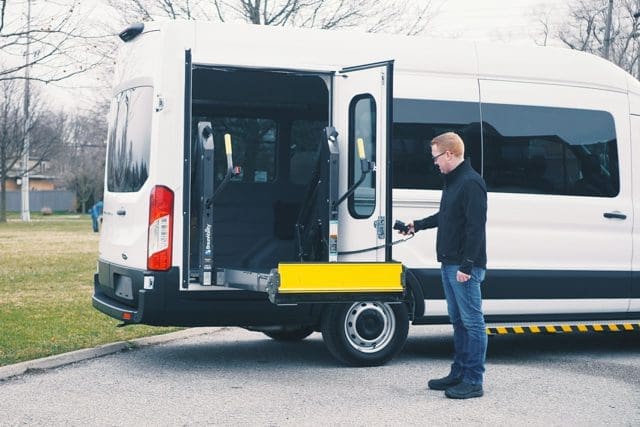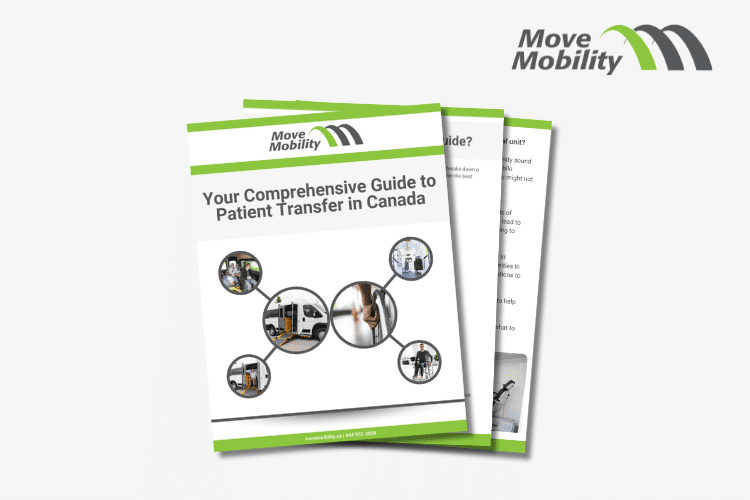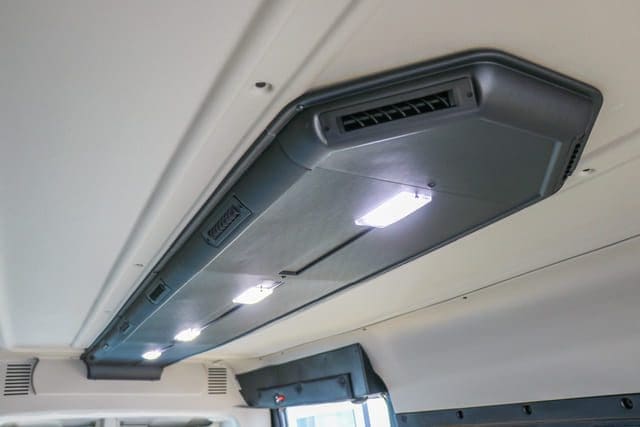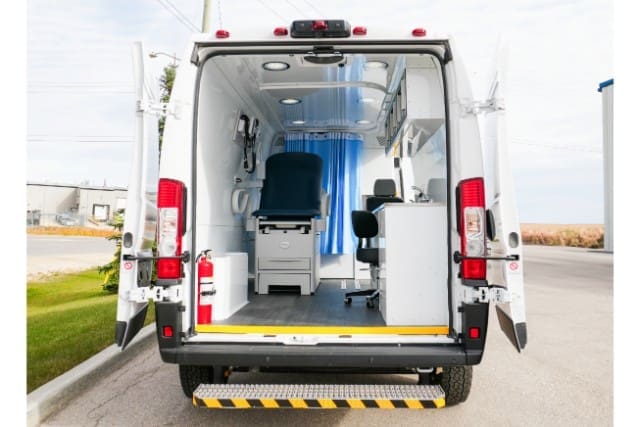Wondering about the safety features on wheelchair van lifts? If you’re helping people who use wheelchairs get around, like clients, patients, or residents, you’ve probably asked yourself, “Is this lift safe enough?” That’s a real concern. When safety isn’t clear, it can feel like a big risk every time someone uses the lift. One small issue can lead to injuries, stress for your staff, or even legal trouble.
That’s a gap a lot of organizations don’t realize they have until something goes wrong.
But when you understand how a wheelchair lift for a van is built for safety, everything changes. You stop worrying. Your team feels more confident. And your riders feel respected and secure every time they get on board.
Here’s what that could look like:
- No liability concerns: You reduce risk and protect your organization.
- Less chance of accidents: Built-in safety features do the heavy lifting.
- More trust in your services: Riders feel respected and safe.
- Confident staff: Your team knows the equipment is solid.
- Smoother operations: No second guessing, no hold-ups, just peace of mind.
At MoveMobility, we’ve been building wheelchair-accessible vehicles that reduce barriers to transportation for over 20 years across Canada. We’ve worked with care teams, nonprofits, and health groups just like yours. And even though we build these vans ourselves, we’re here to help you find the right fit, no pressure, no bias.
In this article, you’ll learn about the safety features of wheelchair van lifts, which will bring peace of mind to your organization, clients, and their families.
What’s the interlock system safety feature on wheelchair van lifts?

One of the most important safety features on wheelchair van lifts is the interlock system. It’s a small feature that makes a huge difference when your clients are using a wheelchair lift for a van.
So what is it?
The interlock system is like a smart safety lock. The van wheelchair lift won’t work unless:
- The engine is running
- The van is in park
- The parking brake is on
Why does this matter? Imagine one of your staff is helping a passenger onto the lift. They’re halfway up, and the driver forgets to set the parking brake, or worse, shifts into gear too early. Without the interlock system, that van could roll. Even a small movement can cause someone to lose balance or fall. But with the interlock system? The wheelchair lift won’t move an inch.
This safety feature allows your staff to focus on the person they’re helping, not on the vehicle’s gear.
Let’s take a look at an example: A community care team in Manitoba is using an old wheelchair van that doesn’t have this feature. One day, a staff member forgot to place the van in park and accidentally let their foot off the brake while someone was on the lift. The van moved slightly, and the passenger panicked. No one got hurt, but it was close. Now, with the interlock system in their new van, that stress is gone.
Up next, let’s talk about another smart feature that keeps riders safe on a wheelchair lift for a van.
Seatbelt system: Keeping wheelchairs secure on the lift
Another key safety feature on wheelchair van lifts is the built-in seatbelt or restraint belt on the wheelchair platform lift for a van. This belt isn’t for the person; it’s for the wheelchair itself. Its job? To stop the wheelchair from rolling around while it’s on the lift.
When someone is being lifted into a van with a wheelchair lift, there’s a moment when the platform is raised off the ground, and the wheelchair is facing the edge. Without anything holding it in place, a sudden jolt or even just a shift in balance could cause the wheelchair to tip or roll off.
That’s where the belt comes in.
How it works: Once the person is positioned on the lift, your staff clips the belt onto the wheelchair. This holds the wheelchair steady and prevents the wheels from moving back too far while the lift goes up or down.
Why it matters: Let’s say your team is helping someone who’s new to using a powered wheelchair. They may not know how much to brake or may forget in the moment. The belt acts like a safety net, protecting both them and your staff from a scary situation.
This small but powerful detail is built into every van wheelchair lift we install. It’s one more way your team can offer safe, steady service, without worry.
Flat surface requirement: Why does lift deployment need level ground?
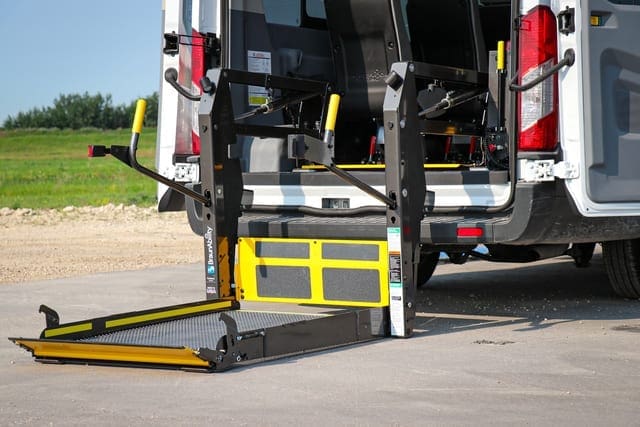
One of the lesser-known but important safety features on wheelchair van lifts is the need for a flat, level surface when using the lift. It might seem like a small thing, but it makes a big difference in how safe and smooth the experience is for your riders.
When a wheelchair lift deploys, the platform needs to stay even with the ground. If your van with a wheelchair lift is parked on a slope or uneven ground, the platform can tilt. That tilt can cause a wheelchair to shift or roll, and that’s where accidents can happen.
What can go wrong on uneven ground?
- The van wheelchair lift might not deploy at all.
- The lift could get stuck partway.
- The platform may tilt, making riders feel unsafe.
- A wheelchair might roll or tip if the ground is too sloped.
Here’s an example: Picture a support worker parking on a steep driveway to drop off a client. They activate the lift, but it doesn’t lower all the way. The wheelchair starts to roll back because of the angle, and the rider grabs the rails in panic. Now, instead of a smooth drop-off, it’s a stressful moment for everyone.
This is why your team should always look for flat parking spots before using the lift. It’s an easy habit that adds a big layer of safety.
Let’s move on to another key feature: Side barriers that help prevent wheelchairs from rolling off the lift.
Side barriers: Keeping wheelchairs from rolling off the lift
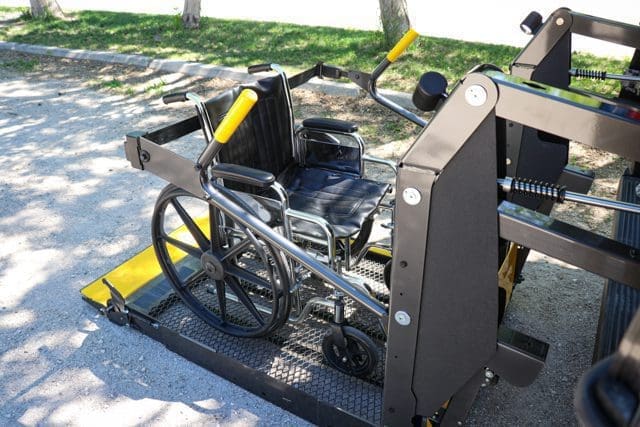
Another key safety feature on wheelchair van lifts is the side barriers built right into the platform. These are small walls on either side of the wheelchair platform lift for a van that rises up during use. Their job is simple but important: Stop the wheelchair from rolling off the sides while the lift is moving.
When someone is being lifted into a van with a wheelchair lift, there’s always a bit of movement, especially if they’re nervous, adjusting their position, or using a power chair. Without side barriers, even a small shift to the left or right could cause a serious fall.
What do the side barriers do?
- Prevent sideways rolling: Keeps the wheels safely inside the platform.
- Boost rider confidence: Passengers feel more secure knowing they’re protected.
- Add extra peace of mind for staff: No need to hover or panic while the lift moves.
Imagine this situation: A team is helping someone who just had knee surgery. They’re in a manual wheelchair and feel a bit wobbly. As the lift starts to rise, the chair starts to veer to one side. With no side barriers, they could roll off. But because the van wheelchair lift has those protective walls, the chair stays right where it should.
This small feature makes a big difference, especially when transporting new riders, children, or older adults who might need extra stability.
What other features do wheelchair lifts for vans have?
By now, you know the key safety features of wheelchair van lifts, but there are a few more built-in features that you should be aware of.
Here’s what you get with the wheelchair lifts on the vans from MoveMobility:
- Heavy-duty, transit-grade lifts: Our lifts are built for daily use. They’re strong, reliable, and designed for the kind of work your team does every day. Perfect for healthcare, outreach, and community programs.
- Room for larger mobility devices: Power chairs, oversized wheelchairs, or scooters? No problem. Our van wheelchair lifts can handle larger, heavier wheelchairs without anyone needing to squeeze or shift awkwardly.
- Manual backup system: If the power goes out or there’s an electrical issue, the lift still works. The manual system means you can still lower or raise the wheelchair platform lift for a van safely. No one gets stuck, and no one has to wait.
These features are all about helping you do your job without stress or second-guessing. When you’re responsible for people’s safety, you want equipment that works every time.
And remember: Whether you’re just starting to look for a van with a wheelchair lift or replacing an old one, it’s always worth asking about safety features first. If you ever want help understanding your options, we’re here to walk you through it, step by step.
Got any questions about wheelchair van lifts?
You came to this article because you had a serious question: Are the safety features on wheelchair van lifts enough to protect the people we care for? When lives are literally in your hands, you need to feel confident that your equipment won’t let you down.
Here’s what you now know:
- Interlock systems keep the van from moving during lift use
- Wheelchair seatbelts stop devices from rolling back
- Flat ground is needed for smooth and safe lift operation
- Side barriers help prevent dangerous side-to-side movement
- Heavy-duty lifts and manual backups prepare you for everyday use and unexpected power issues
We’ve helped hundreds of organizations across Canada find safe, reliable vehicles that make everyday transportation simpler and safer. With years of experience in manufacturing vehicles for organizations in healthcare, outreach, and accessible transport, we understand the challenges you face.
Our team listens, builds with purpose, and works with you to find a solution that actually fits your needs. We’re here because we care about making transportation safe and dignified for everyone. If you have questions, click the button below to speak with a mobility expert who can help.
If you’re not quite ready to chat just yet, no problem. Take a look at some of our other helpful resources to keep learning.
Start by reading through our article or watching the video below on ramps vs. lifts for wheelchair vans. This will give you a better idea of which option to go with.
After that, check out the video below on the top five problems with wheelchair lifts.


